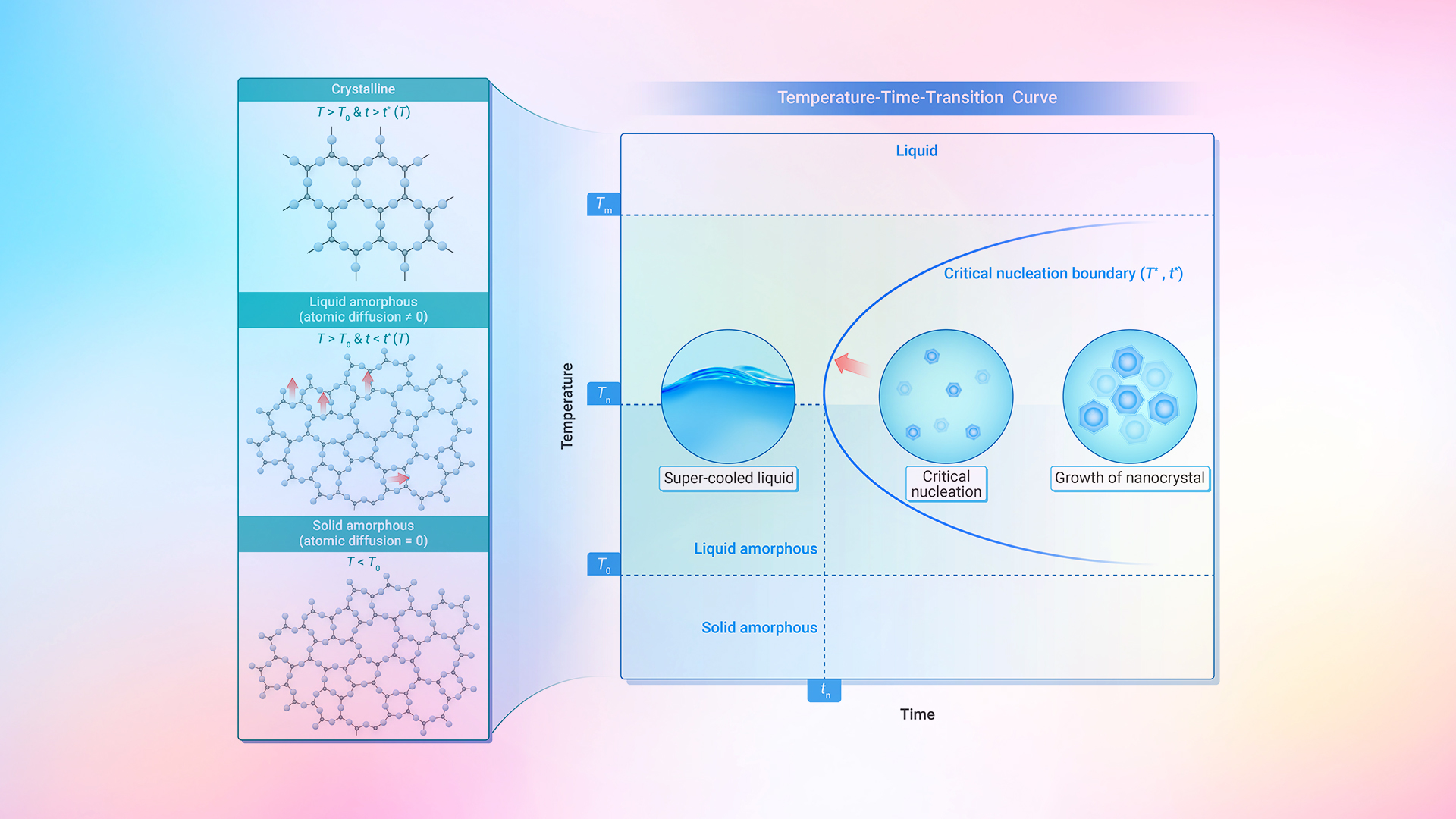Despite a comprehensive understanding in modern materials physics regarding the equilibrium state of crystalline matter, there is still a paucity of understanding surrounding the nature of the amorphous state and the non-equilibrium process of transitioning from an amorphous state to a crystalline state to a crystalline state. In 2005, Science listed “the nature of glass” as one of the ten most challenging scientific questions in physics this century.
The traditional Time-Temperature-Transformation (TTT) curve theory, which combines the classical nucleation theory and crystal growth theory, is an important tool for solving this scientific problem. However, in the traditional TTT curve theory, a key physical parameter, the critical nucleation interface energy, is determined by using an empirical formula composed of time-independent physical quantities. As a result, the TTT curve formed by this method deviates significantly from the experimental data.

The research group of Chair Professor X.-D. Xiang from the Department of Materials Science and Engineering at the Southern University of Science and Technology (SUSTech) has recently made a significant advancement in understanding the glassy nature of matter.
Their work, titled “Quantitative understanding of the initial stage of liquid to crystalline or amorphous phase transitions”, has been published in the journal The Innovation Materials.
Novel approach to refining the TTT curve
This study addresses the common mistake of substituting time-independent physical quantities into the conventional TTT curve theory formula, particularly the viscosity of materials employing the traditional VFT viscosity model. As the VFT model comprises solely time-independent physical quantities, it applies solely to the equilibrium state. The researchers introduced a new approach by revising the temperature expression in the VFT formula to include a critical nucleation temperature (T*) related to the critical nucleation time (t*). This led to the creation of a new viscosity model that is suitable for non-equilibrium states.
In their new model, the team derived a formula that correlates nucleation interface energy with viscosity under a critical state, refining the TTT curve to align closely with experimental data from various glass-forming systems.

By correlating nucleating interface energy with viscosity in critical states and limiting temperature variables in the traditional TTT curve to critical nucleation temperature T* associated with the critical nucleation time t* determined by experiment, the team solved the quantitative theoretical problem of the TTT curve. The refined TTT curve quantitative model demonstrates a high degree of agreement with the experimental data from various glass formation systems.
Further discussion of critical parameter T0
The refined TTT curve allows the determination of a series of process physical quantities, including the temperature T0, which serves as the lowest crystallization temperature of the amorphous phase. Below T0, the amorphous phase transitions from liquid to solid, providing a stable structure without structural relaxation, thereby offering a definitive solution to the “nature of glass”.
These findings offer new insights into the long-standing debate surrounding the Kauzmann paradox, which involves the behavior of entropy in glassy and crystalline states as temperatures approach absolute zero. In the temperature range below T0, the team confirmed that the amorphous solid state exists with a slower entropy decrease than that of the crystalline state due to vibrational differences, ensuring the entropy of the disordered amorphous state will always be higher than that of the ordered crystalline state. This observation avoids violations of the third law of thermodynamics. This enables them to accurately determine T0 values for the transition from liquid to solid in the amorphous phase, thus resolving the long-standing Kauzmann paradox.
This quantitative theory not only enhances the understanding of the “nature of glass”, but also advances the field of amorphous phase transition storage. However, measuring these transitions remains a challenge, with incubation times spanning over ten orders of magnitude for diverse materials, with the shortest timescales reaching subpicoseconds, necessitating advanced experimental measurement technology.
Graduate student Haode Dong from the Department of Materials Science and Technology at SUSTech is the first author of the paper. Professor X.-D. Xiang, Professor Hong Wang from Shanghai Jiao Tong University (SJTU), and Professor Zikui Liu from Pennsylvania State University are the co-corresponding authors. Other contributors to the study include Dr. Peng Zhang, Dr. Mingyang Qin from SUSTech, and Dr. Hui Jian from SJTU.
This work was supported by the Shenzhen Basic Research Project and the Major Science and Technology Infrastructure Project of the Material Genome Big Science Device Platform of the Shenzhen Development and Reform Commission.
Paper link: https://doi.org/10.59717/j.xinn-mater.2024.100086
To read all stories about SUSTech science, subscribe to the monthly SUSTech Newsletter.
Proofread ByAdrian Cremin, Yingying XIA
Photo ByDepartment of Materials Science and Engineering